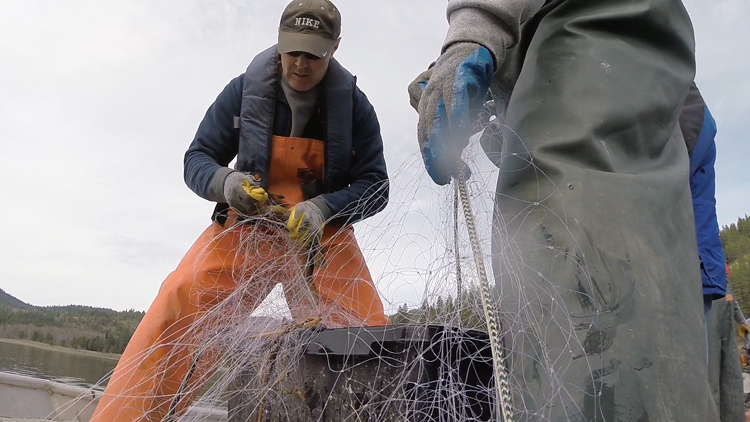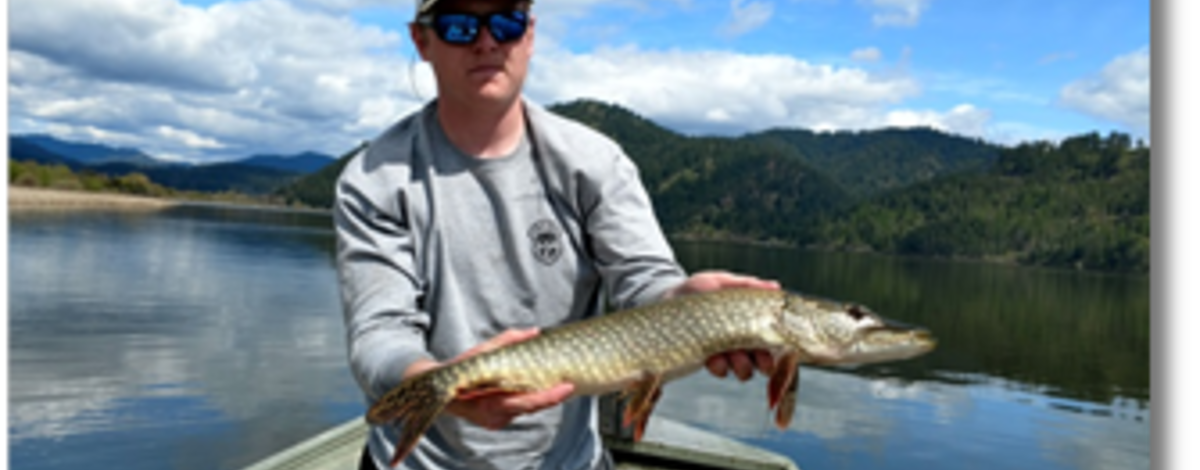
This is a joint press release between Idaho Fish & Game and the Coeur d'Alene Tribe.
Biologists with the Coeur d’Alene Tribe will resume gill netting efforts this spring to reduce northern pike numbers in Windy Bay, Benewah, Chatcolet, Round, and Hidden Lakes. In cooperation with the Idaho Fish and Game, the project aims to reduce pike predation on native, lake-run cutthroat trout in select areas of Lake Coeur d’Alene.
Netting in 2021 will occur from March 15 to May 28 and Oct. 1 to Nov. 31. In order to minimize impacts to recreational anglers, netting is suspended all weekends and during the summer from Memorial Day weekend through September. Spring netting targets shallow, shoreline habitat where pike prefer to spawn. Fall netting is used to monitor the pike population response and to capture fish that may not be vulnerable in the spring.
Northern pike were illegally introduced in Lake Coeur d’Alene during the 1970s. In the spring, pike congregate in shallow areas to spawn, including near the mouths of tributaries where migratory westslope cutthroat trout must pass in order to spawn in streams. This creates a “predator trap” that is believed to reduce cutthroat populations in some watersheds.
Fish and Game biologists work closely with the Tribe to ensure there are no impacts to other gamefish populations, such as the popular largemouth bass fishery. Largemouth bass made up 6.5% of the total catch during the past two years and 81% were released alive.
“Bass mortality has been low and netting modifications have been made that should lead to even less mortality this year. As a result, we don’t expect any negative impacts to the bass fishery from pike removal,” said Andy Dux, Regional Fishery Manager for Fish and Game.
Fish and Game conducted a bass survey on Chatcolet and Benewah lakes in 2019. That survey will be repeated in the future to monitor how bass respond to pike removal.
Monitoring effectiveness
Biologists are starting to see positive results for cutthroat trout in Lake Creek, the main tributary to Windy Bay where pike suppression efforts began in 2015. Nearly 500 adult cutthroat ascended Lake Creek in 2019, the largest spawning run observed in more than 20 years. COVID 19 restrictions prevented tribal staff from monitoring the spawning run last spring.
Jon Firehammer, Fisheries Research Biologist for the Coeur d’Alene Tribe, reported that juvenile cutthroat that leave the Lake Creek watershed are returning to spawn at rates four times higher compared to the ten years prior to the start of the suppression program.
“These responses are undoubtedly due to a reduction in predation and a more favorable environment in the lake for cutthroat,” Firehammer said.
Consistently higher rates of survival are projected to rebuild the population of cutthroat in the watershed.
Netting was expanded to Benewah, Chatcolet, Round and Hidden Lakes in 2019 to help cutthroat that spawn in southern tributaries such as Benewah Creek and those in the lower St. Joe River. Native bull trout also stand to benefit since they use the area as part of their migration between the lake and the upper St. Joe watershed.
Suppression efforts in these southern lakes are challenging given the expanse of spawning habitat available to pike and their greater numbers. The Tribe’s work in 2019 was largely exploratory, testing different types of nets and using radio transmitters to track pike as they made their seasonal movements. Overall, 1,409 pike were removed during the first year of expanded operations and another 585 were removed in 2020. The capture rates of northern pike were substantially lower in 2020 than in 2019, indicating that the population in this area of the lake was less abundant last year. The planned netting efforts for 2021 will provide another year of data to evaluate the effectiveness of the suppression program in depleting this population. This should help inform whether the trend for declining numbers of pike is real and sustained.

“The tracking work we did was important as it indicated that locations outside our target area for netting likely serve as important spawning centers. Many pike moved out of the lake and up the St. Joe River in early spring,” said Angelo Vitale, Fisheries Program Manager with the Tribe.
The tracking work will continue in 2021 with funding assistance from the U.S. Fish and Wildlife Service. The interest in this program is high relative to how it might benefit bull trout that are currently listed as threatened under the Endangered Species Act.
Many of the pike that were removed from the lake were donated for consumption and were distributed from the Blue Goose Sporting Goods store in St. Maries.
“Making pike available for consumption over the last two years was appreciated by many community members, so we are pleased that the Tribe is continuing that program,” said Dux.
In coming years, the Tribe will evaluate the effectiveness of the southern lakes netting program by monitoring changes in the pike population and the survival of juvenile cutthroat trout and the number of adult cutthroat that return to spawn in Benewah Creek.
In 2017, the Tribe and Fish and Game conducted a public opinion survey of Lake Coeur d’Alene anglers. Survey results showed strong public support for northern pike suppression in Windy Bay. In addition, there was strong support for localized suppression in the southern end of the lake if efforts in Windy Bay showed promise for improving cutthroat trout abundance.
“Survey results were supportive of this type of work and the intent is to strategically target areas where suppression of northern pike can provide the greatest benefit to native cutthroat trout,” said Vitale.

